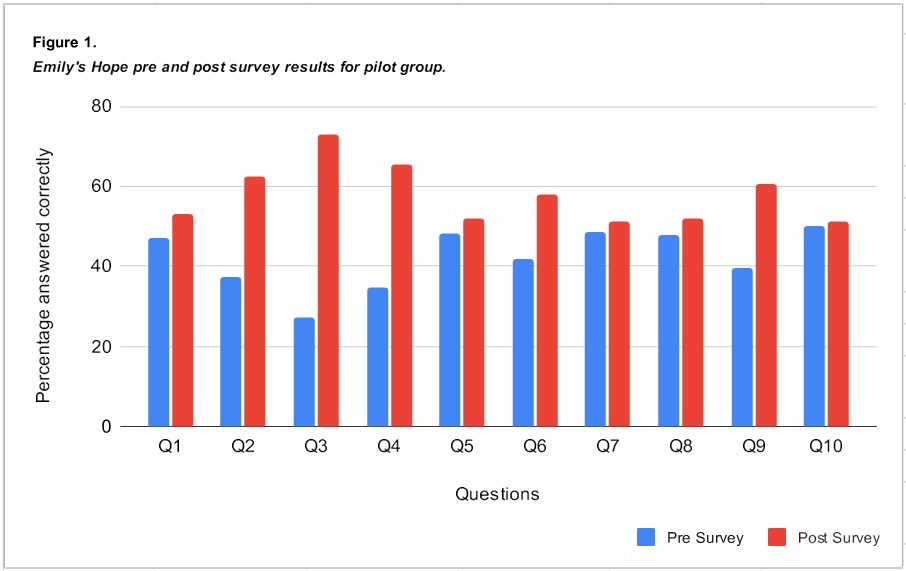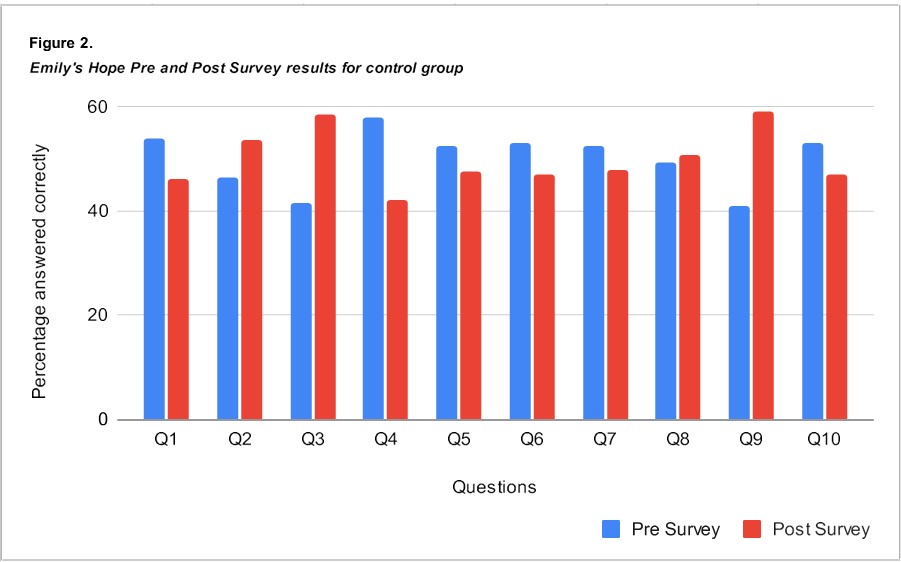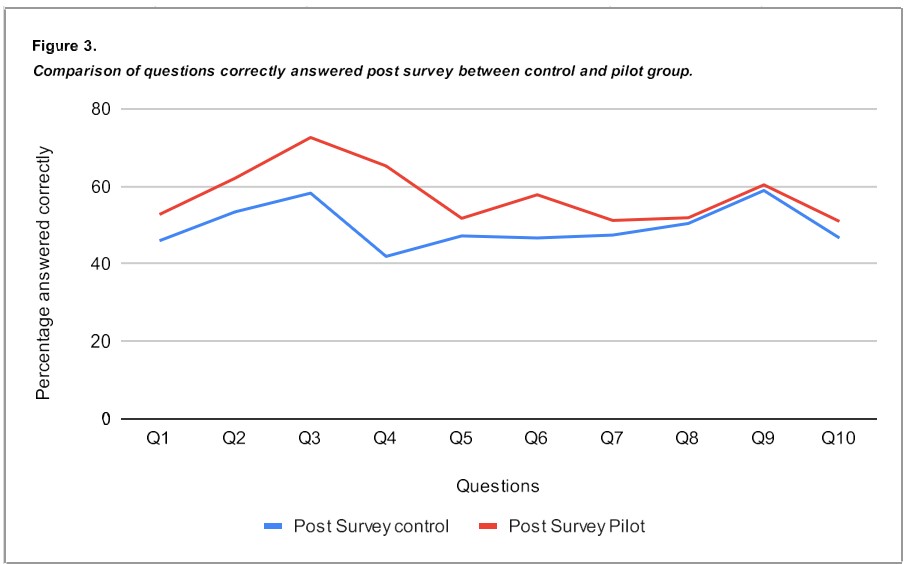International Journal of Addiction Research
OPEN ACCESS | Volume 2 - Issue 1 - 2025
ISSN No: - | Journal DOI: -
Tiffany Thoelke, Melissa Dittberner*, Lindsey Gray, Will Schweinle
University of South Dakota, 414 East Clark Street Vermillion, SD 57069 USA.
*Corresponding author: Melissa Dittberner, University of South Dakota, 414 East Clark Street Vermillion, SD 57069 USA.
Received: July 06, 2024
Accepted: June 10, 2024
Published: June 30, 2024
Citation: Thoelke T, Dittberner M, Gray L, Schweinle W. (2024) “Building Blocks of Prevention: Assessing Substance Use Education Among Third Graders.” International Journal of Addiction Research, 1(1); DOI: 10.61148/ IJAR/012
Copyright: © 2024 Melissa Dittberner. This is an open access article distributed under the Creative Commons Attribution License, which permits unrestricted use, distribution, and reproduction in any medium, provided the original work is properly cited.
This study aimed to evaluate the impact of the Emily’s Hope Substance Use Prevention Curriculum on third graders' understanding of key health concepts. Focused on a cohort from nine elementary schools in the Midwest, this research explored changes in knowledge about brain function, body awareness, and the dangers of substance use disorder with an emphasis on fentanyl. As the prevalence of adolescent substance use presents ongoing concerns, early educational interventions are becoming increasingly recognized as vital for reducing the risk of future substance use (CDC, 2023).
Methodologically, the study employed pre- and post-education assessments via Google Forms to quantify knowledge shifts among participants. The control group initially comprised 515 students, with 434 students participating in the post-survey. In the pilot phase, 342 students completed the pre-survey and 321 completed the post-survey.
There was a significant difference pre to post curriculum survey in students' comprehension of substance use disorders, recognition of brain structures, understanding of the adverse effects of substances on physiological and neurological health, and heightened awareness of the specific risks associated with fentanyl.
Parents of the participants were provided with the option to opt out of the study as well as the educational material. This ensured that participation from all individuals was voluntary and respectful of each unique family and their individual beliefs.
This research supports ongoing efforts to integrate such curricula more broadly across educational settings to fortify the foundation for a healthy brain and body from an early age.
The long-term goal is for this curriculum to serve as a foundational element of prevention education at the community, state, and national levels, thereby empowering students with the knowledge and skills to navigate life’s challenges. Within it, the necessary tools to cultivate resilience, lessen risk factors, and develop the skills needed to lead successful, healthy lives.
substance use prevention; elementary education; third graders; prevention curriculum; substance use disorder
Introduction
Despite a reported decrease in illicit substance use in 2023, overdose deaths have alarmingly continued to rise, with a 14% increase from 2020 to 2021. This surge resulted in approximately 112,024 lives lost in a 12-month period to overdoses, equating to 307 deaths each day (CDC, 2023).
Substance misuse encompasses the improper use of both illicit and legal substances, with diverse underlying factors such as trauma, stress, genetics, or mental health issues often driving youth towards such behaviors (APHA, 2023; Hernandez; CHOC, 2023).
In 2022, an estimated 48.7 million individuals aged 12 and older were diagnosed with a substance use disorder (SUD), and 29.5 million were identified with an alcohol use disorder (AUD). Notably, 8 million of these individuals were grappling with co-occurring SUD and AUD (Substance Abuse and Mental Health Services Administration, 2023). The combined health and financial burdens of these disorders are staggering, with the National Institute on Drug Abuse noting an annual healthcare cost exceeding $232 billion in the United States alone (2023).
Prevention science, which focuses on identifying risk factors and protective measures against behavioral and psychological disorders, highlights the importance of early intervention (NIH, 2023). Studies advocate for enhancing school connectedness, increasing parental involvement, and implementing targeted prevention curricula at an early age to mitigate the risks associated with substance use (NIH, 2021).
Currently, evidence-based prevention curricula like Safety First and Life Skills Training are implemented, with the former targeting high school students and the latter offering a three-year program adaptable to various stages of youth development.
To this end, a curriculum development committee at Emily’s Hope—comprising substance use professionals, addiction medicine specialists, a child psychiatrist, educators, administrators, and counselors—crafted an evidence-based prevention curriculum for third graders. In the 2022-2023 academic year, a pilot and control study were conducted with third and fourth graders in nine schools across the Midwest. Utilizing Google Forms, students completed pre-survey questionnaires anonymously and were assessed post-curriculum to determine the retention of the lessons taught or whether there was a difference between the control and pilot groups. This study aimed to measure the effectiveness of this eight-lesson prevention education on student understanding of how their brains and body's function, manage emotions and pressures, and comprehend the impact of substances on their development and decision-making abilities.
Methodology
Participants
The students that participated in this research study included third- and fourth-grade students, aged 8 to 9, from nine schools across the upper Midwest. Initially, 342 students participated in the pre-survey during the pilot phase, with 321 completing the post-survey. The lower post- survey frequency is likely due to absences at the time.
Two control schools were involved: one with third graders and the other fourth graders. The control group initially had 515 pre-survey responses, which reduced to 434 participants for the post-survey. One of the control schools had a technical issue and were unable to submit their post-survey answers leading to fewer post-survey responses.
Materials
The pilot program was designed to be age-appropriate and developmentally suitable for young learners. It features a comprehensive toolbox, including grade-specific chapter books, engaging animated videos, a mix of small and large group activities, and thoughtfully designed activity sheets. Each chapter is carefully aligned with a corresponding lesson, tailored to that grade level’s cognitive and emotional development. This structured yet flexible approach allows educators to adapt the lessons to their classroom dynamics, promoting creativity and active participation. To reinforce learning and assess understanding, the curriculum incorporates short quizzes and exit tickets at the end of each lesson.
Curriculum Design
The substance use prevention curriculum is structured into eight comprehensive modules, each crafted to address crucial aspects of health and well-being from a holistic perspective. Delivered by schoolteachers or counselors, these modules can be flexibly implemented throughout the year allowing for seamless integration into existing educational schedules.
Interactive teaching methods, including case studies, role-playing, group discussions, and hands- on activities, are used to provide students with practical knowledge and real-world applications of the concepts taught. This approach ensures that students not only learn about substance use and its effects but also develop critical thinking and decision-making skills that are vital for personal growth and development. The eight modules are as follows:
My Body - Introduces students to basic anatomy and physiology, emphasizing the importance of taking care of one's physical health.
My Brain - Focuses on neurobiology and how the brain functions, setting the stage for understanding how substances can affect brain health.
My Brain on Substances - Explores the impact of substances on the brain, including both short-term effects and long-term consequences.
Your Health/My Health - Encourages a broader understanding of community health and how individual choices impact the health of others.
Medication Safety - Teaches the principles of safe medication use, distinguishing between proper use and misuse.
Substance Use Disorder - Provides a comprehensive look at substance use disorder, including its signs, symptoms, and the recovery process.
Emotions - Examines how emotions are processed in the brain and how substance use can alter emotional regulation.
Pressures - Addresses social and environmental pressures that can lead to substance use, offering strategies for resilience and resistance.
To enhance learning outcomes, each lesson is supported by grade-specific chapter books, animated videos, group activities and activity sheets. Furthermore, the curriculum includes continuous assessment tools that help teachers monitor progress and adapt the pace and focus of lessons to meet the specific needs of their students. This comprehensive design educates students about the risks associated with substance use while also equipping them with the necessary tools needed to make healthy and informed choices.
Procedures
Baseline Data Collection: Prior to the introduction of the substance use prevention curriculum, a comprehensive baseline assessment was conducted to capture initial data on the students’ knowledge, attitudes, and behaviors related to substance use. This initial data collection involved administering pre-test surveys using google forms. The surveys were designed to gauge the students' existing understanding of how substances affect the brain and body, and their attitudes toward substance use.
Post-Intervention Data Collection: A similar set of post-test educational surveys were administered to the same students after curriculum delivery. The pretest/post-test design allowed researchers to measure the effectiveness of the curriculum in enhancing students’ awareness and understanding of the dangers associated with substance use and its physiological impacts.
Results and Discussion
Chi-square tests (see Figure 1-3) were used to test students' responses from pre- to post- curriculum implementation and revealed a statistically significant improvement in students' understanding across all assessed areas among the pilot study. Please note that with a Bonferroni correction for ten hypotheses tests (α = .005), all results are significant.






Strengths
The implementation of the Emily's Hope Substance Use Prevention Curriculum across various districts significantly expanded the participant base, enhancing the robustness and diversity of the data collected.
A key strength of this study was inclusive participation from various educational settings, including schools in rural communities, tribal schools, and institutions representing diverse socioeconomic backgrounds. This wide-ranging participation enabled the research to capture a broad spectrum of educational impacts and responses, providing a rich dataset for assessing the curriculum’s effectiveness.
The involvement of schools from different demographic and cultural contexts also allowed the study to evaluate how a range of factors influence the acceptance and efficacy of the curriculum. This inclusivity is crucial for developing educational interventions that are adaptable and effective across all communities but that is also sensitive to the unique needs of underserved and underrepresented communities and individuals.
Overall, the diverse and extensive participant base has strengthened the study’s conclusions, suggesting that the curriculum can be successfully integrated and beneficial in a variety of educational environments, thereby supporting its potential for broader national and international adoption.
Limitations and Improvements
While the curriculum has demonstrated promising outcomes, it is important to acknowledge the potential influence of external factors on the significant gains observed in information retention.
To mitigate these influences and enhance the accuracy of our results, we have undertaken several measures to refine the assessment tools used in the study.
One key area of improvement was the revision of ambiguous or confusing questions within our surveys. For example, the abbreviation "PTA" previously included "Parent Teacher Association" as a potential answer, which led to confusion among students. This option in the current year has been removed to clarify that "PTA" in the context of our curriculum stands for "Pause, Think, Act." Additionally, an unexpected response pattern emerged with students mistakenly associating "Fentanyl" with "Pizza Topping." This misunderstanding prompted a review and subsequent refinement of the question to ensure clarity and relevance.
Another limitation encountered was the challenge of comparing baseline and post-curriculum results for the same individuals due to the anonymous nature of data collection. This anonymity, while crucial for ethical reasons, limited our ability to track individual progress over time. Future iterations of the study may explore methods to securely link pre- and post-test data while maintaining confidentiality to enhance longitudinal analysis.
Furthermore, qualitative feedback from teachers and administrators was not initially incorporated into our data collection strategy. Recognizing the value of these insights in understanding the practical implementation and impact of the curriculum, future research will include mechanisms to capture these important perspectives. Creating designated spaces within our data collection framework for such qualitative contributions will help enrich our understanding of the curriculum's effectiveness and areas for further enhancement.
These steps are part of our ongoing commitment to refining the curriculum and its evaluation methods, ensuring that our findings are robust, and that the curriculum continues to meet the needs of diverse student populations effectively.
Ethical ConsiderationsThe research study was conducted with a strong commitment to maintaining the highest ethical standards and was reviewed and deemed exempt by the University of South Dakota Institutional Review Board.
Conclusion
This significant statistical outcome not only underscores the curriculum's effectiveness but also highlights the potential of targeted educational interventions in elevating students' competency and knowledge in critical areas. The marked improvement in survey scores reflects the curriculum’s success in engaging students and enhancing their educational experience concerning substance use prevention.
The control group does, however, show significant improvements in 4 (2,3,8 and 9) out of 10 questions. The reason for this could be due to the education provided already in the classroom or for reasons unknown outside of school.The Emily's Hope Substance Use Prevention pilot program's main goal was to evaluate the retention of critical information about substance misuse among third graders. The structured pre- and post-assessments showed improvement in students’ knowledge following the curriculum, which underscores the curriculum’s effectiveness in imparting essential information on the risks of substance misuse, fostering awareness of brain and body health, and enhancing safe and informed decision-making abilities.
The curriculum was designed to engage young minds, emphasizing early intervention as a pivotal strategy in mitigating the risks of future substance use disorders and potential overdoses. The notable improvements of the study affirm the potential of targeted educational initiatives in shaping health-conscious attitudes and behaviors from an early age. Looking forward, the expanded rollout of this curriculum across kindergarten through fifth grade in multiple states for the 2023-2024 school year represents a significant step towards broadening its impact. This expansion will allow for a more comprehensive data set and provide a robust foundation for evaluating the program's long-term sustainability and adaptability. Continued research is crucial to refine and validate the effectiveness of the Emily’s Hope Substance Use Prevention Curriculum, shaping a generation more resilient against the challenges of substance misuse.
Abbreviations
None?
Nomenclature
None to specifically identify?
Figures and Tables
Do we have figures/tables from statistics?
Appendix
Are there additional pieces of information necessary for this publication?
Funding Sources
None
Acknowledgment
Do we need to acknowledge Beacom’s?